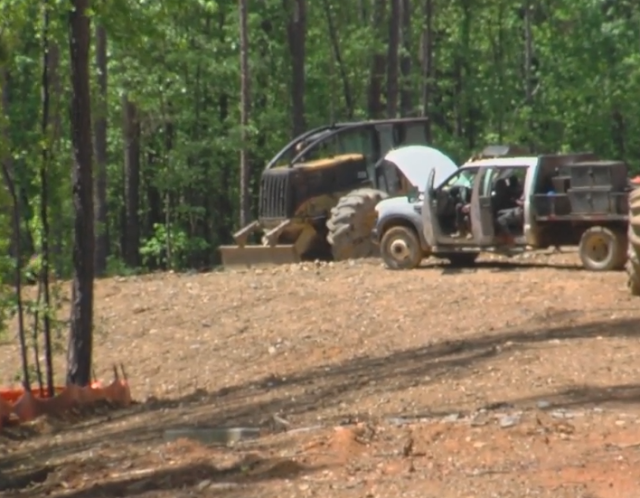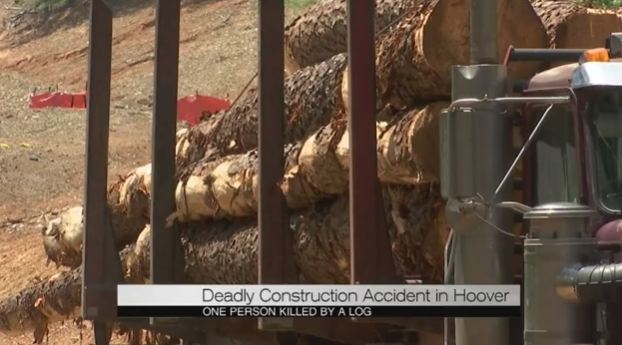Brayford Trucking fined $100K for death of oil-sands worker
Jordan Gahan, 21, drowned 3 years ago when an excavator he was operating plunged through ice at work-site
By Carly Stagg, CBC News Posted: Apr 28, 2017 10:37 AM MT Last Updated: Apr 28, 2017 3:03 PM MT

Leica Gahan, whose son Jordan died in a workplace accident in 2014, is in Calgary for Brayford Trucking's sentencing in the death of her son. The company has pleaded guilty. (Danielle Nerman/CBC)
Jordan Gahan was just 21 when he died at an oilsands site in northern Alberta three years ago.
The New Brunswick man was doing remediation work at a site two hours north of Fort McMurray, Alta., on March 14, 2014, when the excavator he was operating fell through the ice.
According to his mother, Leica Gahan, her son somehow made it out of the cab, which was under four metres of water, but he drowned before he reached the surface.
"The next thing they reported was his hard hat floated up and his body floated up after," she said.

Jordan Gahan moved out west to help fun his true passion — racing. His mother said he built his first race car at the age of 17. (Leica Gahan)
Company pleaded guilty
Jordan Gahan's family and friends were in a Calgary courtroom Friday as Brayford Trucking Ltd., Gahan's employer at the time of his death, was sentenced on charges of failing to protect an employee.
The company initially faced five charges in connection to Gahan's death:
- Failure to ensure the health and safety of workers.
- Failure to ensure a worker is trained in the safe operation of equipment.
- Failure to eliminate or control an identified workplace hazard.
- Failure to ensure equipment is used in accordance with manufacturer's specifications.
- Failure to test the ice to ensure the ice would support the load placed upon it.
In the courtroom on Friday, three of the charges were withdrawn. Brayford pleaded guilty to failure to ensure its worker was trained in the safe operation of equipment and failure to test the ice.
Provincial court Judge Harry Van Harten accepted a joint sentencing submission that saw Brayford fined $100,000 and given two-years of corporate probation.
"The Brayfords are clearly not hiding behind a corporate shield," the judge said. "I hope this provides the type of closure that allows people to move on in a better way."
'We can maybe save somebody in the future'
During the sentencing, Van Harten called the accident a "needless death of a young man who died as a result of insufficient safety protocol."
According to an agreed statement of facts, Gahan was not trained to operate an excavator on ice and was unaware of the need to calculate the load of his machine in relation to the thickness of the ice.
Assessments done at the site to test the depth of ice and water were inadequate, the statement of fact said.
"In reality, when you lose a loved one because of somebody else's negligence, how do you possibly compensate for that loss?" said Leica prior to the sentence.
"We can't save my son, but we can maybe save somebody in the future, maybe we can change the way they look at things."
'Clearly no winners here'
Prior to the judge's decision, Brayford's defence lawyer Wilson Chan said the company's reputation and earnings suffered significantly since the incident.
Between 2013 and 2015, the company went from making close to $700,000 to losing more than $400,000. The company has also gone from 25 employees to five.
Since the incident, Brayford has hired a safety consultant and upgraded and expanded its safety program.
"Clearly no winners here," said Chan. "The family and the company have suffered significantly since Jordan's passing."
During a statement read by the company's safety officer and the wife of the owner, Susan Brayford, addressed the Gahan family directly.
Gahan's father interrupted her emotional apology.
"This is too much," he yelled, before the judge asked him to be quiet or leave.
Brayford said there are no words or actions to express how sorry the couple is.
"We take responsibility for the Fort McMurray incident, we take this tragic incident very, very seriously.
"We cannot take away your pain but we can promise you in this court by knowing better we're going to do better."
National Day of Mourning
Brayford Trucking's sentencing coincides with Canada's National Day of Mourning — a day to remember people who died from workplace-related illness or injury.
In 2014, Gahan was one of 169 people who died in a workplace accident in Alberta.
Leica, who is the health and safety representative for her family's construction company back in New Brunswick, says she's glad Brayford Trucking cooperated with the investigation and accepted responsibility in her son's death. She says the accident forever changed both the company and her son's co-workers.
"They never intended for Jordan to die," she said. "I know for a fact there's employees that worked with my son that never worked another day. I know that some of them are still in counselling. It affects everybody."
================
EDMONTON – A 21-year-old man was killed on March 14 while operating a track hoe on a work site north of Fort McMurray.
Occupational Health and Safety (OHS) says he was operating a track hoe on some ice at the bottom of an open pit when the track hoe fell through the ice into the water.
The incident happened around 4 p.m. on March 14, two hours north of Fort McMurray on the East Athabasca Highway, a privately owned road that provides access to Suncor’s Firebag in situ site north of Fort McMurray, as well as Imperial Oil’s Kearl site, and Husky Energy’s Sunrise site.
A spokesperson for Suncor says the man was an employee of Brayford Trucking, a Leduc-based company, who was doing reclamation work on the highway for Suncor as an operator.
Brayford Trucking confirmed the man killed was 21-year-old Jordan Gahan.
Gahan was from Fredericton, New Brunswick.
A spokesperson for Brayford Trucking said the company “is a small, close community” and wants to express their “thoughts and prayers for Jordan’s family.”
The family tells Global News they were notified on Friday.
“Even though he was my younger brother I looked up to him,” said his brother Joshua.
“He was a role model. Not only the best brother anyone could ask for, but a great friend.”
“I miss him tremendously,” Joshua added.
“He lived his life everyday and I am so fortunate I have 21 years of memories that no one can take from me. My family is going to stick together and get through this as best we can.”
A stop-work order has been put in place and OHS is investigating.
In January, a Suncor employee was found dead at the company’s oilsands site in Fort McMurray.
















































